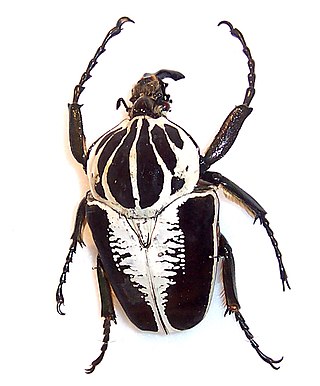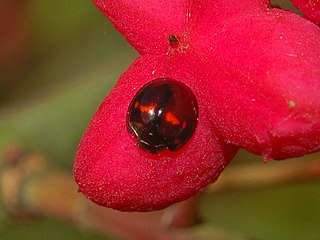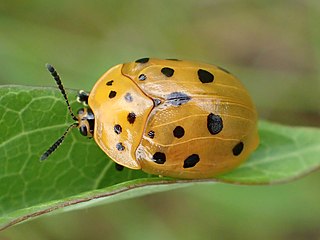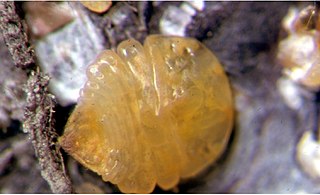
Dermestidae are a family of Coleoptera that are commonly referred to as skin beetles. Other common names include larder beetle, hide or leather beetles, carpet beetles, and khapra beetles. There are over 1,800 species described.

The Goliath beetles are any of the five species in the genus Goliathus. Goliath beetles are among the largest insects on Earth, if measured in terms of size, bulk and weight. They are members of subfamily Cetoniinae, within the family Scarabaeidae. Goliath beetles can be found in many of Africa's tropical forests, where they feed primarily on tree sap and fruit. Little appears to be known of the larval cycle in the wild, but in captivity, Goliathus beetles have been successfully reared from egg to adult using protein-rich foods such as commercial cat and dog food. Goliath beetles measure from 60–110 millimetres (2.4–4.3 in) for males and 50–80 millimetres (2.0–3.1 in) for females, as adults, and can reach weights of up to 80–100 grams (2.8–3.5 oz) in the larval stage, though the adults are only about half this weight. The females range from a dark chestnut brown to silky white, but the males are normally brown/white/black or black/white.

Chilocorus stigma, commonly known as the twice-stabbed ladybug, is a native resident of the United States and Canada but does not live west of the Sierra Nevada.. It also has been introduced to Hawaii. It is shiny black, and there is one red spot on each elytron. The remainder of the body is black as well, but the abdomen is either yellow or red. It is sometimes confused with the "two-stabbed lady beetle", Chilocorus orbus, which is widespread in California.

Phyllophaga is a very large genus of New World scarab beetles in the subfamily Melolonthinae. Common names for this genus and many other related genera in the subfamily Melolonthinae are May beetles, June bugs, and July beetles. They range in size from 12 to 35 mm and are blackish or reddish-brown in colour, without prominent markings, and often rather hairy ventrally. These beetles are nocturnal, coming to lights in great numbers.

Aonidiella aurantii or red scale is an armored scale insect and a major pest of citrus. It is thought to be a native of South China but has been widely dispersed by the agency of man through the movement of infected plant material. In the United States it is known as California red scale. It was first found in California between 1868 and 1875, apparently brought there on planting material imported from Australia.

Coccinellidae is a widespread family of small beetles. They are commonly known as ladybugs in North America and ladybirds in the United Kingdom; "lady" refers to mother Mary. Entomologists use the names ladybird beetles or lady beetles to avoid confusion with true bugs. The more than 6,000 described species have a global distribution and are found in a variety of habitats. They are oval beetles with a domed back and flat underside. They are sexually dimorphic; adult females are larger than males. Many of the species have conspicuous aposematic (warning) colours and patterns, such as red with black spots, that warn potential predators that they taste bad.

The band-winged meadowhawk is a dragonfly of the genus Sympetrum belonging to the family Libellulidae.

Coleomegilla maculata, commonly known as the spotted lady beetle, pink spotted lady beetle or twelve-spotted lady beetle, is a large coccinellid beetle native to North America. The adults and larvae feed primarily on aphids and the species has been used as a biological control agent. Based on name connotation and to avoid confusion with other species also called "spotted ladybeetle", spotted pink ladybeetle is probably the most appropriate common name for this species.

Alaus oculatus, commonly called the eastern eyed click beetle or eyed elater, is a species of click beetle.

Chilocorus is a genus of beetles belonging to the family Coccinellidae, subfamily Chilocorinae.
Rhyzobius lophanthae, commonly known as the purple scale predator or the scale-eating ladybird, is a species of ladybird native to Queensland and Southern Australia. It was introduced into the United States in the 1890s and has since spread over the southern half of the country.

Olla v-nigrum is a species in the family Coccinellidae, in the suborder Polyphaga. The species is known generally as the ashy gray lady beetle. The distribution range of Olla v-nigrum includes Central America, North America, and Oceania. It is usually gray or pale tan with small black spots on its elytra and thorax. However, a variation can resemble Chilocorus orbus. This form is black with two red spots on the wing covers and has white on the edge of the prothorax.
Hemiberlesia lataniae, the latania or palm scale, is a species of armored scale insect in the family Diaspididae. It was first described by the French entomologist Victor Antoine Signoret in 1869 using Latania lontaroides, a species of palm tree endemic to Réunion as its host; since then, it has been found on avocado trees growing in South Africa, Australia, Israel, the United States, and on a range of other plants in many parts of the world.

Aspidiotus destructor, the coconut scale, is a species of armoured scale insect in the family Diaspididae, found in many tropical and subtropical parts of the world. It is a serious pest of coconut and banana, and attacks a range of other fruiting trees and ornamental plants.
Brachiacantha tau, the t-marked larkspur lady beetle, is a species of lady beetle in the family Coccinellidae. In the Brachiacantha genus, the oval-shaped shiny beetles are usually about 2-3 mm in length. The larvae are not usually encountered because they feed on scale insects within ant colonies. Adults are sometimes found on flowers or hunting within foliage in North America.

Chelymorpha cassidea, known generally as the Argus tortoise beetle or milkweed tortoise beetle, is a species of leaf beetle in the family Chrysomelidae. It is found in the Caribbean and North America.

Chilocorus cacti, known generally as the cactus lady beetle or the twice-stabbed cactus lady beetle, is a species of lady beetle in the family Coccinellidae. It is native to the Caribbean region, North America, Central America, and South America. The adults and larvae feed on scale insects and attempts have been made to use it for biological pest control.
Cryptognatha nodiceps, known generally as the coconut scale predator or sugarcane scale predator, is a species of lady beetle in the family Coccinellidae; it is found in the Caribbean region, North America, and Oceania, having been introduced to various countries in an attempt to provide biological pest control of the coconut scale.

Quadraspidiotus juglansregiae, commonly known as the walnut scale, is a species of armoured scale insect in the family Diaspididae. It is native to North America where it feeds on a wide range of ornamental and forest trees and bushes.
Melanaspis glomerata, the sugarcane scale or black scale, is a species of armoured scale insect in the family Diaspididae. It is native to the Indian subcontinent where it is a serious pest of sugarcane.














